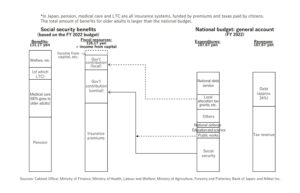December 2022
This report shows the real life of older adults in Japan. Their labour participation rate, financial assets, relationships with neighbours are described first, and then systems such as pension, medical and long-term care are being explained with numbers and figures.
A brief tour of Japan
Tokyo is not the kind of place where one particular location attracts everyone. Rather, the city has a number of busy districts centred around major train stations, as well as many traditional-style streets. For example, Ginza is a traditional high-end shopping district, while younger generations would rather go to Shibuya.
Unlike in 2020 and 2021, when the city was quiet because of COVID-19, Tokyo now is returning to normal, with more people going out and more tourists visiting from across the world.
While it is nice to visit tourist destinations such as Kyoto and Nara, you may also want to explore different neighbourhoods in Tokyo and other places as well. Let us give you a brief tour of different communities in Japan.
When you visit Japan and look around, you will easily find many older adults walking along busy streets around stations. Quite a few of them are in a hurry as they are in the middle of work.
In Japan, the labour participation rate of people aged 65+ is 25.6%, much higher than the OECD average (15.5%).
But many older adults are also strolling the streets, taking their time, and don’t seem to be working.
While Japanese public pension system has a low income replacement rate, it continues to provide many benefits based on the old family structure before women started working outside (e.g., preferential treatments for full-time housewives, generous survivor benefits).
At department stores, you may get the impression that these places wouldn’t survive without the spending power of older customers.
In Japan, people aged 60+ own the majority of financial assets (68.5% of household financial assets). According to a report, shareholders aged 70+ own 41% of Japanese companies’ stocks.
Now, let’s move to residential areas. You can also see many older adults walking and talking on the street. In most cases, women are out with their friends, while men tend to go out alone.
Among people aged 65+, 72.3% said they had ikigai, a sense of purpose/meaning in life (a total of “strongly agree” and “somewhat agree”).
Relationships with neighbours:
82.8% greet them when they run into each other
57.3% have a brief chat outside
50.8% exchange goods
20.3% ask for or being asked for advice/consultation
16.8% go out together for a tea/meal
15.1% enjoy activities together
7.5% help each other when being sick
7.3% help each other in housework and other tasks
Older adults have higher participation rates than any other generations in local events and volunteering.
But if you move further from big cities, you may find communities rather quiet. Why? Because the country is having fewer and fewer children.
In Japan, the population aged 0 to 14 declined by 10% between 2010 and 2020. In 2021, the total fertility rate was 1.30.
On the outskirts of residential areas, you can easily find different types of elder care facilities.
You may also notice many minibuses with older adults in them, running around communities in the morning and late afternoon. These buses are providing transportation to/from adult day care centres. Day care service, including transportation to/from the centres, is covered by Japan’s national long-term care (LTC) insurance.
Japan has a LTC insurance system for older adults, funded half by public money and the other half by premiums. Under the system, services are available also to people with mild disabilities, who are independent in basic activities of daily living (e.g., eating, toileting) but need some assistance or monitoring in instrumental activities (e.g., housework, dressing). The system also provides a care manager for each user to coordinate services and includes support for community development to help older adults. The system is therefore exceptionally generous and extensive compared with those in other countries across the world.
The number of people eligible to use the LTC insurance services increased by 35%, from 5.062 million at the end of 2010 to 6.818 million at the end of 2020. During the same period, the elderly population increased by 32%.
Over 2 million people, accounting for around 1/3 of the LTC insurance service recipients, use the day care service. The spending on this service amounts to nearly 2 trillion yen, or around 20% of the total LTC benefit expenditure (while institutional care accounts for around 1/3 of the total).
When you walk around a town, you see clinics everywhere, each having a speciality such as internal medicine, orthopaedics, and ENT (ear, nose, and throat). There are also many dentists and drug stores. Large drug stores are almost like supermarkets, offering beauty products and everyday items as well as medicines. There, you will also see many older adults.
National medical care spending increased by 15% between 2010 and 2020, but medical care utilization by older adults was reported to have decreased in 2020 due to COVID-19. The spending increased by 19% between 2010 and 2019. Around 60% of the total national medical care spending went to older adults. People in Japan can freely access medical care since the GP system does not exist in the country. Discussions are currently taking place mainly on specialization and collaboration of different medical care functions, promotion of home-based medical care, and promotion of collaboration between medical and social care.
How are these systems funded?
Taxes and insurance premiums are not the only fiscal resources of the systems that support older adults. Japan’s debt to GDP ratio reached 259% in 2021, being the top in the world followed by Greece (224%) and Italy (173%). In other words, Japanese social security systems heavily rely on the national government debt that has been constantly increasing over the years. As most of the debt is spent within Japan, the country is unlikely to face hyperinflation led by credit uncertainty. Yet, since the government cannot keep issuing bonds without limit, this financial situation makes it difficult for the country to invest in essential fields such as growing industries, education, and family support, which may limit future generations’ freedom of policy choices. Japan’s GDP has been slowing down in recent years, falling from 2nd in the world in 2000 to 27th in 2022.

Responsibilities of older adults
An aged society is supposed to be a prosperous and mature society made possible by the efforts of all generations, including older adults’ creative activities based on their rich experience and wisdom. It should never be something that brings stagnation to the current and future societies.
Japanese older adults do have high employment rates, and they do make significant contributions to Japanese economy and community development. Still, considering their responsibilities as members of the growing age group in the country, older adults need to contribute to more effective investments. Rather than depending on the public sector, they should work with the sector to shift the focus of community-based care from “service-oriented and ‘doing-for’ care” to personalized support for well-being that stresses independence and self-determination. They should also contribute to healthy development of children and become key players in enriching communities.
Shinichi Ogami
Advisor, ILC-Japan
Contact the ILC-Japan:
E-mail: ilcjapan@ihep.jp
Website: www.ilcjapan.org/english.html
The International Longevity Centre Global Alliance is delighted to be approved as an Affiliate of the World Health Organization Global Network of Age Friendly Cities and Communities.
20th June 2025
The ILC Europe Network, launched in December 2021, addresses longevity and population ageing in Europe. The Network works to organise policy and research events, share good practice, and engage with policymakers across the continent.
20th June 2025
Young and old united in imagination
Generation Mixer is a creative project connecting primary school children and local older adults through the power of imagination. By inventing and exploring imaginary worlds together, generations build meaningful bonds and discover new talents.
19th June 2025


